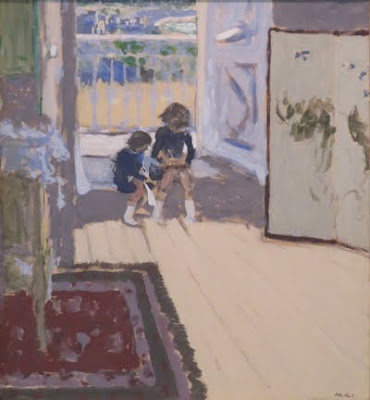Seeing the Hermitage has long been an ambition of mine. I was especially excited about the prospect of visiting the General Staff Building, which houses the Impressionist and post-Impressionist collection.
 |
| General Staff Building, Hermitage, St. Petersburg |
Independent travellers to Russia are required to obtain a visa. This is an expensive, complicated, and time-sensitive procedure.
So travellers are often tempted to book a cruise and register for a group tour, either with the cruise line or with an independent tour company, either of which will obtain a visa for you. The downside of this is that many of these tours list the Hermitage as a destination, but do not actually include a visit to the General Staff Building. If they do, your visit will be limited to an hour or less. AND you are required to stay with the tour guide at all times.
In other words, you can't extend your visit by skipping the group lunch and meeting up with the tour later.
For this reason I would advise anyone interested in spending more time with this exceptional art collection to book a private tour. Though it costs a bit more, remember that the amount is small relative to the cost of the entire holiday.
It was even more heartbreaking because the galleries were virtually empty. A long, lingering look at this collection would have been an unforgettable experience.
And now for another caveat about the collection of Impressionist and post-Impressionist paintings.
Some of these works were acquired by the Russians from the Germans at the end of the second World War, in what was seen by the Soviets as reparation for war damages. The difficulty is that the Germans acquired these paintings by confiscating them from Jewish owners. While the process of restitution to the rightful owners is ongoing in many countries, Russia has been slow to engage with these efforts.
Seeing all these masterpieces in one place is a thrilling, albeit tainted, experience.
Below are a few of the hundreds of gems in the collection.
 |
| Woman in Green, Henri Matisse, 1909 acquired in 1930 from the State Museum of Modern Western Art, Moscow formerly in the S. I. Shchukin collection |
 |
| Bathers, Paul Cézanne, c. 1890-91 From Otto Krebs's collection |
 |
| Portrait of Lydia Delectorskaya, Henri Matisse, 1947 donated by L.N. Delectorskaya, 1967 |
 |
| Young Woman in a Blue Blouse (Portrait of Lydia Delectorskaya), 1939 Henri Matisse, donated by L.N. Delectorskaya in 1971 |
 |
| Dance, Henri Matisse, 1910 acquired in 1948 from the State Museum of Modern Western Art, Moscow, formerly in the collection of S.I. Shchukin |
 |
| The Red Room (Harmony in Red), Henri Matisse, 1908 acquired in 1948 from the State Museum of Modern Western Art, Moscow, formerly in the collection of S.I. Shchukin |
 |
| View of Collioure, Henri Matisse, c. 1905 acquired in 1948 from the State Museum of Modern Western Art, Moscow, formerly in the collection of S. I. Shchukin |
 |
| Bouquet (Vase with Two Handles), Henri Matisse, 1907 acquired in 1934 from the State Museum of Modern Western Art, Moscow, formerly in the collection of I. A. Morozov |
 |
| Still Life with Dishes and Fruit, Henri Matisse, 1901 acquired in 1934 from the State Museum of Modern Western Art, Moscow, formerly in the collection of S. I. Shchukin |
 |
| Bottle of Pernod, Table in a Café, Pablo Picasso, 1912 |
 |
| Absinthe Drinker, Pablo Picasso, 1901 acquired in 1948 from the State Museum of Modern Western Art, Moscow, formerly in the collection of S. I. Shchukin |
 |
| View of the Seine, Maurice de Vlaminck, c. 1906 acquired in 1948 from the State Museum of Modern Western Art, Moscow, formerly in the collection of Ivan Morozov |
 |
| Port de Menton, Albert Marquet, 1905 from the G.E. Haasen collection |
 |
| Children, Edouard Vuillard, 1909 from M. O. Tsetlin's collection |
 |
| View of Fort Samson, Grandchamp, Georges-Pierre Seurat, 1885 from Bernhard Koehler's collection |
 |
| Fruit, Paul Cézanne, 1879-1880 from S. I. Shchukin's collection |





































